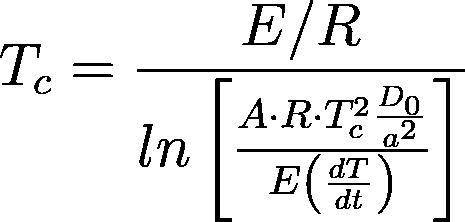
Need Help with Units (Updated) I am trying to iteratively calculate the Closure Temperature (Tc) of an arbitrary radiogenic isotope system given the activation energy (E), diffusivity (d_o/a^2), and cooling rate (dT/dt). Values are: Closure Temp (Tc): 600C = 873.15K (A random number I picked for the first iteration) Activation Energy (E): 50000 cal/mol Ideal Gas Constant: 1.987 cal*K/mol A: 55 (unitless) Diffusivity (D(nought)/a^2): 100 cm^2/s Cooling Rate (dt/dT): 10 deg. C / million years = (3.171*10^ -13) deg. C / second Important note: Our professor said that D(nought) units will cancel Cooling rate (dt/dT) units. I've gotten it down to: ![\frac{1}{ln\left [ \left ( K-273.15 \right )* ^{\circ}C*cm^{2} * (3.1536*10^{13}})\right *K]}](/tpl/images/1744/7055/0e5cb.png) Im having the most trouble converting C to K. Our answer for Tc should be in degrees Celcius and we are to plot Tc as a function of cooling rate.
Im having the most trouble converting C to K. Our answer for Tc should be in degrees Celcius and we are to plot Tc as a function of cooling rate.


Answers: 3


Other questions on the subject: Physics

Physics, 22.06.2019 08:00, JuanTorres7
The arrival of in the early days of europa’s existence could have formed its ocean. it is likely that the water experienced similar to earth. it is also possible that this water is retained beneath europa’s surface and in its atmosphere due to europa’s . 1.) a. precipitation b. water vapor c. icy debris 2.) a. gravitational compression b. biochemical cycling c. radiogenic heating 3.) a, gravity b. magnetic field c. heat energy for plato
Answers: 3


Physics, 22.06.2019 18:00, NotYourStudent
Which of the following is not a physical property of mattera. melting pointb. heat of combustionc. viscosityd. boiling point
Answers: 1

Physics, 23.06.2019 08:30, lalkjlkeu9709
Because air contracts as it cools, the air pressure inside a freezer is typically lower than on the outside. why do ice cubes inside a freezer tend to shrink over time? the ice sublimes, and then the water vapor deposits as ice crystals on the sides of the freezer. the ice melts, and then the liquid freezes as ice crystals on the bottom of the freezer. the ice dissolves oxygen from the air, forming a denser crystalline matrix. the ice reacts chemically with carbon dioxide in the air, forming gaseous carbon compounds.
Answers: 1
You know the right answer?
Need Help with Units (Updated) I am trying to iteratively calculate the Closure Temperature (Tc) of...
Questions in other subjects:

Spanish, 10.12.2020 14:00


English, 10.12.2020 14:00

Computers and Technology, 10.12.2020 14:00



History, 10.12.2020 14:00


History, 10.12.2020 14:00

Mathematics, 10.12.2020 14:00



